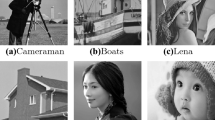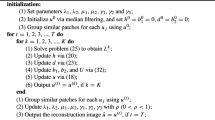Abstract
Ultrasound images are often contaminated by speckle noise during the acquisition process, which influences the performance of subsequent applications. Hence, it is necessary to design an effective algorithm for despeckling to obtain a clearer ultrasound image. According to the low-rank property of ultrasound images and the statistical property of similar image patch matrices, a nonlocal low-rank model with an improved data fidelity function (LRDF) is introduced in this paper, which integrates the weighted nuclear norm minimization (WNNM) and an improved data fidelity term. The advantage of WNNM is that it can adaptively assign weights on different singular values to preserve more details in restored images. The fidelity term deduced from log-compressed images fits better to ultrasonic data. We adopt the alternating direction method of multipliers (ADMM) to solve this nonconvex optimization problem. The experimental results on simulated images and real medical ultrasound images verify the reweighting strategy is helpful in this application and demonstrate the excellent performance of the proposed method compared with other five state-of-the-art methods.















Similar content being viewed by others
References
Liu G, Kang H, Wang Q, Tian Y, Wan B (2021) Contourlet-CNN for SAR image despeckling. Remote Sens 13(4):764
Passah A, Amitab K, Kandar D (2021) SAR image despeckling using deep CNN. IET Image Proc 15(6):1285–1297
Singh P, Shree R (2018) A new SAR image despeckling using directional smoothing filter and method noise thresholding. Int J Eng Sci Technol 21(4):589–610
Singh P, Shree R (2020) A new homomorphic and method noise thresholding based despeckling of SAR image using anisotropic diffusion. J King Saud Univ Comput Inf Sci 32(1):137–148
Singh P, Shree R, Diwakar M (2021) A new SAR image despeckling using correlation based fusion and method noise thresholding. J King Saud Univ Comput Inf Sci 33(3):313–328
Kuan DT, Sawchuk AA, Strand TC, Chavel P (1985) Adaptive noise smoothing filter for images with signal-dependent noise. IEEE Trans Pattern Anal Mach Intell PAMI–7(2):165–177
Tomasi C, Manduchi R (1998) Bilateral filtering for gray and color images. In: Sixth international conference on computer vision (IEEE Cat. No. 98CH36271), IEEE, pp 839–846
Yu Y, Acton ST (2002) Speckle reducing anisotropic diffusion. IEEE Trans Image Process 11(11):1260–1270
Mei K, Hu B, Fei B, Qin B (2019) Phase asymmetry ultrasound despeckling with fractional anisotropic diffusion and total variation. IEEE Trans Image Process 29:2845–2859
Kushwaha S, Singh RK (2017) An efficient approach for denoising ultrasound images using anisotropic diffusion and teaching learning based optimization. Biomed Pharmacol J 10(2):805–816
Sudeep P, Palanisamy P, Rajan J, Baradaran H, Saba L, Gupta A, Suri JS (2016) Speckle reduction in medical ultrasound images using an unbiased non-local means method. Biomed Signal Process Control 28:1–8
Yang J, Fan J, Ai D, Wang X, Zheng Y, Tang S, Wang Y (2016) Local statistics and non-local mean filter for speckle noise reduction in medical ultrasound image. Neurocomputing 195:88–95
Yu H, Ding M, Zhang X, Wu J (2018) PCANet based nonlocal means method for speckle noise removal in ultrasound images. PLoS ONE 13(10):e0205390
Kokil P, Sudharson S (2020) Despeckling of clinical ultrasound images using deep residual learning. Comput Methods Programs Biomed 194:105477
Zhang J, Lin G, Wu L, Cheng Y (2016) Speckle filtering of medical ultrasonic images using wavelet and guided filter. Ultrasonics 65:177–193
Leal AS, Paiva HM (2019) A new wavelet family for speckle noise reduction in medical ultrasound images. Measurement 140:572–581
Dutt V (1995) Statistical analysis of ultrasound echo envelope. Ph.D. dissertation, Biophysical sciences–biomedical imaging–Mayo Graduate School
Tao Z, Tagare HD, Beaty JD (2006) Evaluation of four probability distribution models for speckle in clinical cardiac ultrasound images. IEEE Trans Med Imaging 25(11):1483–1491
Jauhri KS, Thakur RK, Maji SK (2020) A blind metric based variational approach for ultrasound image denoising. In: 2020 international conference on contemporary computing and applications (IC3A), IEEE, pp 34–39
Sagheer SVM, George SN (2017) Ultrasound image despeckling using low rank matrix approximation approach. Biomed Signal Process Control 38(sep.):236–249
Ghofrani S, Jahed-Motlagh M, Ayatollahi A (2001) An adaptive speckle suppression filter based on nakagami distribution. In: EUROCON’2001. International conference on trends in communications. Technical Program, Proceedings (Cat. No. 01EX439), IEEE, vol 1, pp 84–87
Coupé P, Hellier P, Kervrann C, Barillot C (2009) Nonlocal means-based speckle filtering for ultrasound images. IEEE Trans Image Process 18(10):2221–2229
Jin Z, Yang X (2011) A variational model to remove the multiplicative noise in ultrasound images. J Math Imaging Vis 39(1):62–74
Lu J, Yang H, Shen L, Zou Y (2019) Ultrasound image restoration based on a learned dictionary and a higher-order MRF. Comput Math Appl 77(4):991–1009
Zhu L, Fu C-W, Brown MS, Heng P-A (2017) A non-local low-rank framework for ultrasound speckle reduction. In: Proceedings of the IEEE conference on computer vision and pattern recognition, pp 5650–5658
Wright J, Ganesh A, Rao S, Ma Y (2009) Robust principal component analysis: exact recovery of corrupted low-rank matrices
Gu S, Xie Q, Meng D, Zuo W, Feng X, Zhang L (2017) Weighted nuclear norm minimization and its applications to low level vision. Int J Comput Vision 121(2):183–208
Yang H, Zhang H, Luo Y, Lu J, Lu J (2021) Ultrasound image restoration using weighted nuclear norm minimization. In: 2020 25th international conference on pattern recognition (ICPR), IEEE, pp 5391–5397
Gu S, Zhang L, Zuo W, Feng X (2014) Weighted nuclear norm minimization with application to image denoising. In: Proceedings of the IEEE conference on computer vision and pattern recognition, pp 2862–2869
Candes EJ, Wakin MB, Boyd SP (2008) Enhancing sparsity by reweighted l 1 minimization. J Fourier Anal Appl 14(5–6):877–905
Arnal J, Mayzel I (2020) Parallel techniques for speckle noise reduction in medical ultrasound images. Adv Eng Softw 148:102867
Loupas T, McDicken W, Allan PL (1989) An adaptive weighted median filter for speckle suppression in medical ultrasonic images. IEEE Trans Circuits Syst 36(1):129–135
Krissian K, Kikinis R, Westin C-F, Vosburgh K (2005) Speckle-constrained filtering of ultrasound images. In: 2005 IEEE computer society conference on computer vision and pattern recognition (CVPR’05), IEEE, vol 2, pp 547–552
Boyd S, Parikh N, Chu E, Peleato B, Eckstein J et al (2011) Distributed optimization and statistical learning via the alternating direction method of multipliers. Found Trends Mach Learn 3(1):1–122
Lin Z, Chen M, Ma Y (2010) The augmented lagrange multiplier method for exact recovery of corrupted low-rank matrices. arXiv preprint arXiv:1009.5055
Osher S, Burger M, Goldfarb D, Xu J, Yin W (2005) An iterative regularization method for total variation-based image restoration. Multiscale Model Simul 4(2):460–489
Wang Z, Bovik AC, Sheikh HR, Simoncelli EP (2004) Image quality assessment: from error visibility to structural similarity. IEEE Trans Image Process 13(4):600–612
Blanchet G, Moisan L (2012) An explicit sharpness index related to global phase coherence. In: 2012 IEEE international conference on acoustics, speech and signal processing (ICASSP), IEEE, pp 1065–1068
Feng H, Hou B, Gong M (2011) Sar image despeckling based on local homogeneous-region segmentation by using pixel-relativity measurement. IEEE Trans Geosci Remote Sens 49(7):2724–2737
Szkulmowski M, Gorczynska I, Szlag D, Sylwestrzak M, Kowalczyk A, Wojtkowski M (2012) Efficient reduction of speckle noise in optical coherence tomography. Opt Express 20(2):1337–1359
Yang H, Li J, Shen L, Lu J (2020) A convex variational model for restoring SAR images corrupted by multiplicative noise. Math Probl Eng. https://doi.org/10.1155/2020/1952782
Examples ftp files-kidney (2020) http://field-ii.dk/examples/
Image database-ultrasound cases (2020) http://www.ultrasoundcases.info/
Buades A, Coll B, Morel J-M (2005) A non-local algorithm for image denoising. In: 2005 IEEE Computer society conference on computer vision and pattern recognition (CVPR’05), IEEE, pp 60–65
Acknowledgements
This work was supported by the General Program of National Natural Science Foundation of China [Grant Numbers 61806147, 61972265, and 11871348]; Natural Science Foundation of Guangdong Province of China [Grant Number 2020B1515310008]; Project of Educational Commission of Guangdong Province of China [Grant Number 2019KZDZX1007]; Natural Science Foundation of Shenzhen [Grant Number JCYJ20170818091621856]; the Shenzhen Key Laboratory of Media Security; the State Key Laboratory of Robotics (2019-O15).
Author information
Authors and Affiliations
Corresponding author
Additional information
Publisher's Note
Springer Nature remains neutral with regard to jurisdictional claims in published maps and institutional affiliations.
Appendix: proof of theorem 2
Appendix: proof of theorem 2
Proof
Let \(U_{t}\varSigma _{t}V^{T}_{t}\) denote the SVD of the patch matrix \(\frac{Z^{t}}{\mu _{t}}+X^{t+1}\) in the \((t+1)\)-th iteration, where \(\varSigma _{t}=\{diag(\sigma ^{1}_{t},\sigma ^{2}_{t},\ldots ,\sigma ^{m}_{t})\}\). One can see \(L^{t+1}=U_{t}{\mathcal {S}}_{\frac{\lambda w}{\mu ^{t}}}\left( \varSigma _{t}\right) V^{T}_{t}\) according to the conclusion (3), where \({\mathcal {S}}_{\frac{\lambda w}{\mu ^{t}}}(\varSigma _{t})_{ii}=\max \left( \sigma ^{i}_{t}-\frac{\lambda w_{i}}{\mu ^{t}},0\right) \). So with respect to (14), it is reasonable to deduce that
which implies that \(\{Z^{t}\}\) is bounded.
Then, we analyze the boundedness of \({\mathcal {L}}(X^{t+1}, L^{t+1}, Z^{t}, \mu ^{t})\). Since X and L are the globally optimal solutions of (11) and (13), we can hold that
Combining (10) and (14), it is not hard to show
which yields
where \(\tau \) represents the upper bound of sequence \(\Vert Z^{k}-Z^{k-1}\Vert ^{2}_{F}\). One can see that \(\left\{ \frac{\tau (\rho +1)}{2\mu ^{0}\rho ^{k-1}}\right\} \) is a geometrical sequence and \(\frac{1}{\rho }<1\) is the common ratio, which means \(\lim \limits _{t\rightarrow \infty }\sum ^{t}_{k=1} \frac{\tau (\rho +1)}{2\mu ^{0}\rho ^{k-1}}\) converges. Hence, we can conclude that \({\mathcal {L}}(X^{t+1}, L^{t+1}, Z^{t}, \mu ^{t})\) is upper bounded.
Based on (10) and (14), there is
where \(G(X^{t})=\sum \frac{(X^{t}_{ij}-Y_{ij})^{2}}{X^{t}_{ij}}\). Considering the function \(G(X^{t})=\frac{(X^{t}-Y)^{2}}{X^{t}}\) for \(X^{t}>0\), it is easily to prove that \(G(X^{t})\) is a nonnegative convex function. This property together with the fact that all terms on the right side of (A.5) are bounded means that \(\{X^{t}\}\) and \(\{L^{t}\}\) are bounded and \(X^{t}\nrightarrow 0\). Since \(\{Z^{t}\}\), \(\{X^{t}\}\) and \(\{L^{t}\}\) all are bounded and infinite sequences, according to the Weierstrass’s accumulation point theorem, there exists at least one accumulation point for \(\{Z^{t}, X^{t}, L^{t}\}\), which is a feasible solution to (10). Then, it follows that
For the optimization function \(X^{t+1}=\mathrm {arg} \min _{X}G(X^{t})+\frac{\mu ^{t}}{2}\left( \frac{Z^{t}}{\mu ^{t}}+X^{t}-L^{t}\right) ^{2}\) with \(G(X^{t})=\frac{(X^{t}-Y)^{2}}{X^{t}}\), its first-order optimality is in the form of
where \(\nabla G(X^{t+1})=1-\frac{Y^{2}}{(X^{t+1})^{2}}\). Integrating with (14), it is simplified as
Next we have
Since \(\{X^{t}\}\) is bounded, \(X^{t}>0\) and \(X^{t}\nrightarrow 0\), \(\nabla G(X^{t+1})\) is bounded. In addition, \(\lim \limits _{t\rightarrow \infty }\frac{1}{\mu ^{t}} =\lim \limits _{t\rightarrow \infty }\frac{1}{\mu ^{0}\rho ^{t}}=0\). Therefore, we can immediately claim that
Eventually, according to (14), we can prove \(\lim \limits _{t\rightarrow \infty }\Vert L^{t+1}-L^{t}\Vert _{F}=0\) as follows:
where \(U_{t-1}\varSigma _{t-1}V^{T}_{t-1}\) denotes the SVD of the patch matrix \(\frac{Z^{t-1}}{\mu ^{t-1}}+X^{t}\) in the t-th iteration, and then \(L^{t}=U_{t-1}{\mathcal {S}}_{\frac{\lambda w}{\mu ^{t-1}}} \left( \varSigma _{t-1}\right) V^{T}_{t-1}\). \(\square \)
Rights and permissions
About this article
Cite this article
Yang, H., Lu, J., Luo, Y. et al. Nonlocal ultrasound image despeckling via improved statistics and rank constraint. Pattern Anal Applic 26, 217–237 (2023). https://doi.org/10.1007/s10044-022-01088-x
Received:
Accepted:
Published:
Issue Date:
DOI: https://doi.org/10.1007/s10044-022-01088-x




